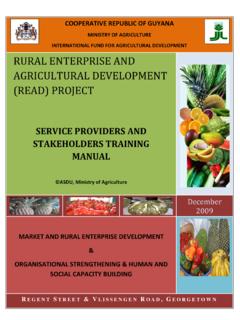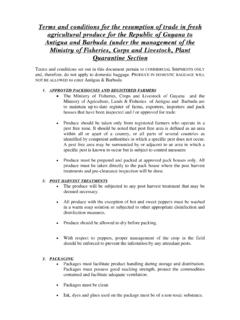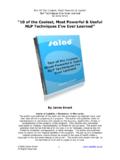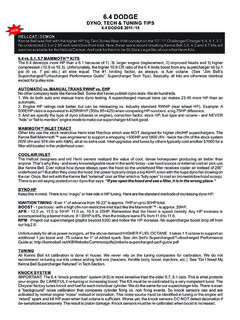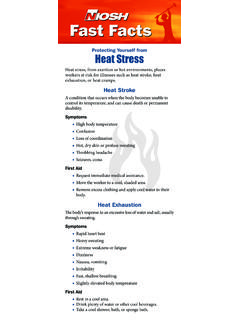Transcription of Harvest Maturity Indices Ideally, the fruit should be ...
1 Harvest Maturity Indices Breadfruit is usually ready for Harvest about 3 months after flowering. The proper stage for harvesting breadfruit depends on the intended use. Breadfruit has a high starch content and is used as a vegetable when mature but not ripe, and as a dessert when ripe. During ripening, the starch turns to sugar and the fruit develops a sweet custard taste. The principal external methods of determining Harvest Maturity are skin colour, texture and appearance of the fruit surface and firmness. Breadfruit should be harvested when green in colour and firm in texture if it is to be used as a starchy vegetable. The fruit should be left to ripen and harvested at a later stage when used as a dessert.
2 The skin colour of ripe fruit becomes yellow-green with red-brown areas. In addition, the stem of ripe fruit becomes yellow-green in colour. The texture and appearance of the fruit surface shows Harvest Maturity . The surface of breadfruit is patterned with irregular polygon shaped sections that flatten and enlarge when mature. Breadfruit harvested as a starchy vegetable should have sections that are angular and ridged noticeably that stick out on the surface, while the individual segments of dessert-stage fruit should be smoother, flatter, and more round. Harvest Maturity can be judged by the occurrence of latex stains on the surface of the fruit and a lack of shine. fruit are ready for Harvest as a starchy vegetable once small drops of latex appear on the surface or brown stains become noticeable.
3 The amount of brown staining increases as the fruit become fully ripe. fruit firmness can also be used to determine Harvest Maturity . Unripe starchy fruit will be solid and not yield when squeezed, while ripe dessert-stage fruit will be noticeably softer and yield when squeezed. The principal internal Indices of breadfruit Maturity are flesh colour and sugar composition. The flesh of mature but unripe breadfruit is white, starchy, and somewhat fibrous. Fully ripe breadfruit has a pale yellow flesh colour and is somewhat soft and fragrant. Unripe breadfruit has very little sugar and is consumed primarily for its starchy texture. As the fruit continues to mature it becomes sweeter due to conversion of some of the starch into sugar. Harvest Methods The fruit on a tree are of different physiological ages and do not reach Maturity at the same time.
4 Therefore, harvesting involves climbing the tree and/or using a long pruning pole, where the fruit is cut and caught by hand or in a net, before hitting the ground. Where the fruit can be reached, they should be harvested by snapping the stem of the fruit off the tree at the point closest to the branch, and not the fruit . Latex typically comes from stems cut too short, and will stain the fruit surface brown. Stem length should generally be between 5 cm to cm (2 in to 5 in). When the stem is cut too short, it should be allowed to drain before putting the fruit in the Harvest container. Care must also be taken to avoid damage to the fruit surface during Harvest . Latex also comes from damaged tissue and causes staining. Breadfruit should never be knocked from the tree or dropped to the ground.
5 This will bruise the fruits and cause rapid softening of the tissue and shorten market life. After cutting the fruit from the tree, the fruit should be carefully lowered to the ground and placed on a clean surface in a shaded area with the stem pointed outwards. The stem should be re-cut with a sharp knife to a length of several centimeters. The cut stem should be oriented downward to prevent latex from dripping onto the fruit surface which causes brown staining of the skin. The latex flow will soon end. The fruit should be graded in the field to remove decayed, damaged, undersized, over-ripe, or stem-less fruit . The marketable breadfruit should be transferred to a strong wooden or durable plastic field container that is well ventilated and has a smooth inside finish to avoid damage of the fruit surface.
6 Synthetic sacks or mesh bags should not be used as field containers. The coarse texture of the woven fabric will cause scratches and damage to the fruit surface as the sacks are transported. This can result in more latex stains. The field containers should be carefully loaded and stacked in the transport vehicle to minimize handling damage to the fruit . There should be good ventilation through the field containers and the transport vehicle should have a protective cover over the containers. Ideally, the fruit should be transported during the coolest time of the day in order to reduce heat build-up inside the transport vehicle. Field containers should be unloaded with care immediately after transport to the packaging facility, put in a shaded well-ventilated area and protected from rain.
7 Preparation for Market Cleaning The initial step in preparing breadfruit for market is to clean the surface of the fruit and remove any dirt and leaf tissue. Latex stains should be avoided by using careful harvesting and handling practices. Once the fruit surface has been stained, it is usually not possible to remove the stains. Small scale operations usually choose to clean the individual fruit by wiping them with a damp cloth. Larger volume operations may choose to use a water dump tank or overhead spray wash system to clean the fruit . In order to avoid the spread of disease, the wash water should be clean and regularly sanitized by maintaining a 150 ppm sodium hypochlorite concentration and a pH of This is equal to 2 oz of household bleach (such as Marvex) per 5 gallons of water, or.
8 3 liters of bleach per 100 liters of water. The chlorine level and pH of the wash water should be checked frequently during the day with paper test strips or portable meters. Following cleaning, the fruit should be placed on a flat surface to air dry prior to grading/sorting, possibly waxing, and packing. Grading/Sorting The next step in market preparation is making a final selection of the fruit according to the requirements of the market. The quality requirements of export grade breadfruit are considerably more strict than domestic marketed fruit . However, there are no domestic or international grade standards for breadfruit. Regardless of the market, the fruit should be sorted according to size, shape, firmness, and appearance. The fruit should be mature, firm, clean, free of large latex stains, evenly shaped, free of wounds and cracks, and free of sunburn, insect damage and decay.
9 In addition, the fruit should have an intact green stem with a length of several centimeters. Breadfruit for the export markets should have a minimum weight of kg ( lb) and a maximum weight of 3 kg ( lb). The fruit should be classified into several different sizes. fruit classified as large should weigh between: 2 kg to 3 kg ( lb to 7 lb). fruit classified as small should weigh between kg to 2 kg (3 lb to lb). fruit shape can be either round or oval and the diameter should be between 20 cm to 30 cm (8 in to 12 in). Waxing Breadfruit may benefit from a postharvest wax. Waxing reduces postharvest weight loss, minimizes shriveling, and increases market life. A thin coating of paraffin wax is most commonly used. It is applied by rapidly dipping the fruit in a solution of liquid paraffin.
10 A carnauba-based wax may be used if the market prefers a shiny surface. The simplest ways to make a carnauba wax application are as a manual rub or an overhead spray of water-emulsion wax as the fruit are rotating on a bed of soft brushes. Packing Breadfruit is packed in various types of containers, depending on the market. A strong, stackable, well-ventilated wooden crate is preferred for domestic marketing. The crates should be lined with newspaper to minimize scratches to the surface. Packing of breadfruit in large synthetic or mesh sacks should not be done; these types of containers offer little or no protection to the fruit . Considerable bruising and scratching may occur during transit and handling. Breadfruit destined for export is usually packed in strong, well-ventilated fiberboard cartons weighing either 9 kg or 18 kg (20 lb or 40 lb).
